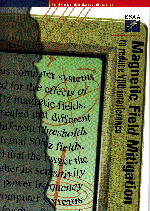Magnetic Field Mitigation Booklet
PUBLICATION NOTICE: JULY 1996

The effect of low frequency magnetic fields on the readability of computer visual display units (VDU's), ie screen display movement or jitter, is an issue which has become prominent in recent times due to increased use of personal computers.
A booklet entitled Magnetic Field Mitigation to Reduce VDU Interference has been produced by the Electricity Supply Association of Australia to provide guidance to engineering consultants, architects, builders, utility personnel, electrical contractors, building managers and others who may have to deal with this issue.
The booklet gives general guidance on magnetic field mitigation techniques as applied to a variety of sources to substantially reduce or eliminate interference to VDU's and other susceptible equipment. Guidance is presented in the form of practical steps which may be undertaken by persons who are not specialists in the area of magnetic fields. These include design steps taken in advance of facility construction, or steps taken post-construction such as shielding, moving, rearranging or replacing the source or the VDU, or a combination of methods. The booklet shows by example how much more effective it is both technically and economically to apply mitigation measures at the design stage for a new installation, rather than applying them retrospectively to an existing installation.
Case studies have been included to give readers practical examples of the mitigation techniques described.
In the majority of reported cases interference of this type is due to building substations, small LV distribution boards, heavy current cables and street power lines adjacent to office buildings. The booklet describes the essential methods of dealing with the problem, ie:
* Increasing the separation distance between the source and the VDU. * Reducing the field at the VDU. * Reducing the field at the source.
Considerable background information is given on the nature of magnetic fields, as well as measurement techniques and field strength calculations. These latter sections may be of interest to those wishing to analyse situations in more detail and have been included to assist in this process.
The booklet was produced under the direction of the ESAA EMF Technical Advisory Committee by Mr Garry Melik , EMF Consultant of Magshield Products International. Further information on the availability and cost of the booklet may be obtained from the ESAA EMF Advisory Group, GPO Box 1823Q, Melbourne Vic. 3001, (Telephone: +613 9670 1017, Facsimile: +613 9670 1105).